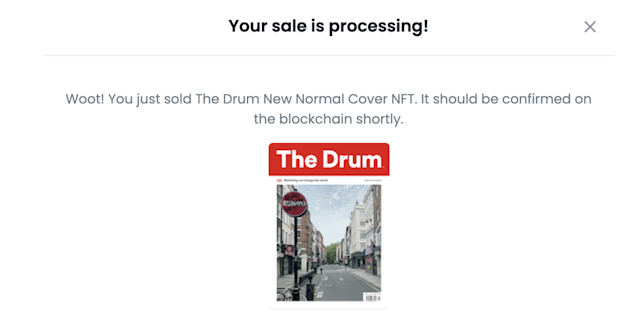What we learned from selling an NFT
This week, as part of our Deep Dive into Retail, The Drum decided to experiment in the world of blockchain and NFTs, selling one of our classic magazine covers in an auction. As the sale comes to an end, we dissect the process and what we think it means for marketing and retail in the future.

The Drum dissects its experiment with NFTs
The topic of NFTs has reached industry hype levels as major brands, such as Coca-Cola, rake in thousands of dollars by selling virtual goods on the blockchain. Experts in the industry have weighed into the subject, stating that it’s a trend that’s here to stay, albeit one that brands need to invest in for the long term.
The Drum has long been a believer in pulling our own sleeves up when it comes to testing new technologies and trends (last year we created out very own virtual influencer, Floresta, and two years ago delved into the world of sonic branding, creating our own audio identity), and so we set about selling our own NFT. Here’s what we learned.
You need some crypto basics
Ultimately the platforms and systems used do mimic other e-commerce experiences, such as marketplaces. However, to get to that stage you do need a wallet with the right cryptocurrency. The Drum spent some time speaking to friends in the industry that have been dabbling in the world of the blockchain to understand what basics and platforms to use. This was invaluable advice as it’s easy to forget you are needing to pump in some cold hard cash to start with.
What you sell is key
The Drum decided to sell a classic cover image as a collectable. This, on the surface, is a great idea. It represents a time gone by for The Drum and the industry, a point in history, and is a nod to the publishing of the past, which is being replaced by technology such as NFTs.
However, what is becoming clear from early major sales in the NFT space is that the core buyers are very much immersed in communities around NFTs and this in itself drives value for items, while brands like Coca-Cola have seen success as its assets are usable in the metaverse.
As a singular asset unlinked to community, gaming and the metaverse, The Drum was only really selling to readers and ones that happened to be active in crypto and NFTs already.
This lesson is echoed in a conversation The Drum has with Matt Law, chief strategy officer at Boson Protocol, experts in this field.
He says: “It would be shortsighted to see the future of metaverse commerce as simply emulating existing retail conventions and stores across digital worlds. The beauty of the metaverse is that it allows companies to break away from tradition and develop wonderlands that are unrestrained by unrealistic costs and the laws of physics.
“Brands are able to create immersive experiences to engage users in both physical and digital worlds. Soon, companies will be able to gamify shopping experiences, creating virtual-to-physical quests, revolutionary events and social interactions that will blur the boundaries between the universe and the metaverse."

The results
The Drum did manage to sell its cover image, thanks to some generous bidding from friends and industry leaders, raising over $500 for our charity partner The Marching Cobras. It’s a worthy result for a small experiment and one that we now know we could have improved.
So what next?
The core premise of an NFT allowing ownership, scarcity and value to digital content is exciting for publishers. Just this week Vogue too has launched its own foray into the space and we expect to see more forward-thinking publishing firms doing the same.
Yet, it’s about more than just finding a new way to sell images or content. The brands that really succeed will immerse themselves in the metaverse… and then reconnect this with the universe.
Boson Protocol’s Law adds that brands can start linking NFTs to real-world redemption. “Considering social capital in the digital sphere is garnered through proof of ownership, exploring NFTs in this way could be a great place for brands to start - even if it’s just window shopping NFT marketplaces.
“Of course, NFTs can do so much more than simply register ownership. Expanding that idea to use NFTs as a contract for a future product or service and enable digital to physical redemptions,” he adds, nodding to service by Boson Protocol to provide public infrastructure for building out decentralized commerce.
There is a very strong case for NFTs becoming an exciting link between the universe and the metaverse. It represents the melding of two huge focus points for brands: commerce and experience. But like any game-changing technology-led trend in the marketing world, take social media, for example, brands need to be all-in. It’s a long-term play, so the sooner you get stuck in, the better.
To find out more about what's next in the future of retail, visit The Drum's retail Deep Dive.

